Coming up with new ideas for your WordPress blog can be a lot of work. More importantly, you can’t – or shouldn’t – rely on intuition alone to figure out which topics will do well with your audience. If you’re not using data to drive that kind of decision, your Search Engine Optimization (SEO) efforts could fall short of your goals.
Services such as Google Trends enable you to figure out what types of topics people are currently searching for. Better yet, you can analyze trends and see when people’s interest in specific topics spike. In this article, we’ll talk about how Google Trends works, and then we’ll teach you how to use it to find new topic ideas for your WordPress blog.
Let’s talk data!
An Introduction to Google Trends
Google Trends enables you to see how many people are looking for a specific term over a period of time. More importantly, it shows you this data in direct relation to all the searches it processes. When one term in particular spikes in relation to other searches, Google classifies it as a ‘trend’.
For example, at the moment we’re working on this article, there’s been a spike in searches related to Britain’s royal wedding. Another popular topic (albeit not as upbeat) concerns news related to North Korea and the United States.

Using Google Trends is easy. You don’t even need to sign up for a Google account to do it. Just visit the Google Trends page and you’ll see which stories are trending at the moment. There are even small graphs next to each title that shows you during which hours traffic spiked for related searches:
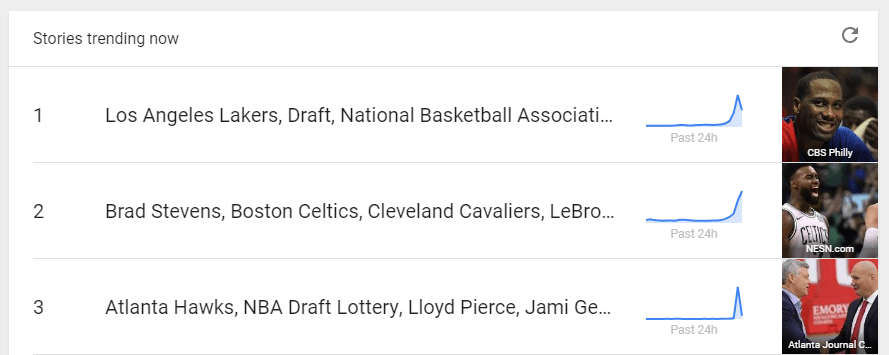
If you want to get more specific, you just need to type the keyword you want to research into the search bar at the top of the page. Let’s see what Google Trends has to say on “WordPress”, for example:

What the graph tells us is that interest in WordPress has held relatively steady over the last 12 months. As you can see, there’s a scale stretching from 0 to 100. In this case, 100 represents the moment in time where the term was at its most popular. The only strong dip in the graph came during December 24-30 in 2017. If we expand our search to the last five years, you can see interest in WordPress peaked in July 2014.
In addition, you can verify that search volume for the keyword drops consistently during each Christmas. This is to be expected since people are too busy eating and worrying about gifts to think about WordPress. We’ll talk more about how to interpret this data to your benefit in the next section, so keep on reading.
Key Features:
- Stay on top of the latest search trends.
- Research a keyword’s popularity over time.
- Explore specific periods of time or regions.
- Segment your results according to web, image, news, and YouTube searches.
- Find out about related keywords and topics.
Price: Free | More Information
How to Use Google Trends to Help You Come Up With New Blog Topic Ideas (3 Ways)
Using Google Trends is simple, but figuring out how to put the data it shows you to work is more difficult. Let’s talk about three practical ways you can use Google Trends to help you come up with new ideas for your WordPress blog.
1. Identify Seasonal Trends
Some seasonal trends are self-evident. For example, searches for electronic devices will spike during Black Friday in several countries. However, most of us run blogs dealing with more niche topics, which makes it harder to figure out when interest will spike for specific search terms.
If you manage to figure out when interest in a specific topic tends to spike, you can time related blog posts to release during that window. This increases the odds of your content becoming more popular, which can net you additional conversions.
Imagine, for example, you run a blog focusing on sports gear reviews and comparisons. You’d like to write more content that focuses on running shoes, but you’re not sure if it will perform well. Let’s see what Google Trends has to say when we look into the term ‘running shoes’:
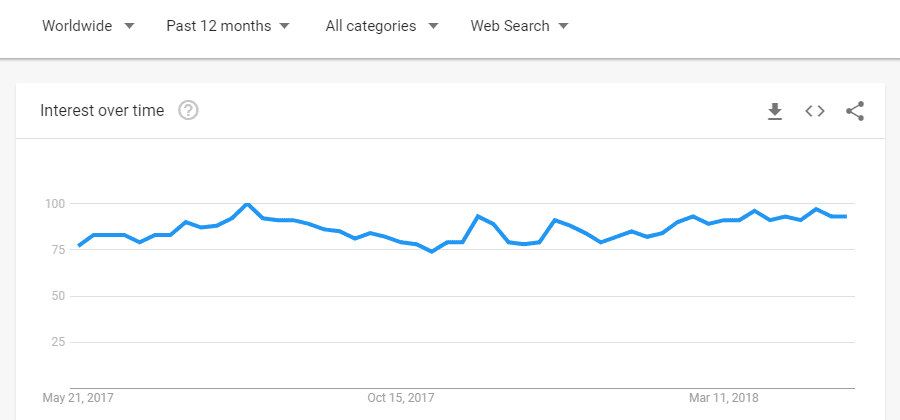
According to the service, interest in running shoes holds steady over the entire year. If you pay closer attention, you’ll see there are two sharp spikes near the beginning of August and April. With this information, you might conclude that it’d be best to hold off until either of those months to publish more content focusing on running shoes. However, the smart move is to verify those trends by expanding the range of our search. Let’s try five years:
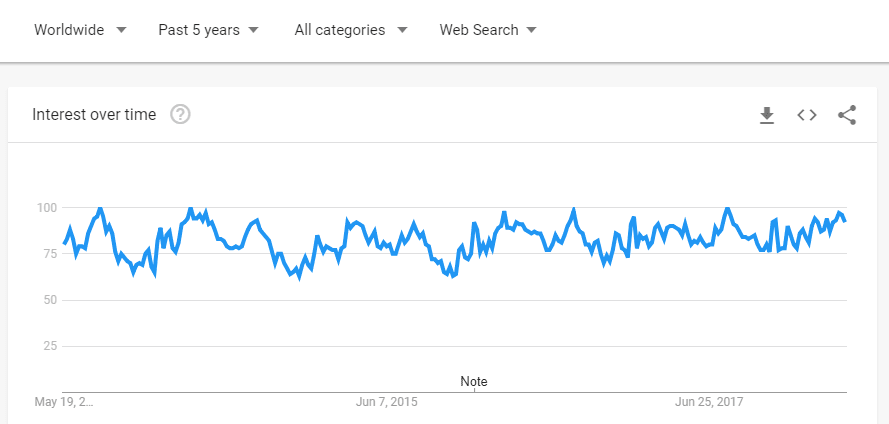
Now the chart has a lot more information to digest. For example, it tells us people really don’t want to think about running between October and December. However, interest tends to pick back up between March and April and then once again at the end of July and during part of August. Let’s sum up what we’ve learned so far:
- Spikes of interest can tell you when it’s best to publish related content.
- A single spike doesn’t necessarily mean there’s a trend.
- Verify any potential trends by going at least a few years back in time.
Identifying seasonal trends is simple, and all you need to do is have a keyword already in mind. If Google Trends tells you now isn’t the right time to write about it, you can always look for related ideas instead (we’ll touch on that in a moment).
However, by default Google Trends shows you worldwide results. If you want to target a specific region of the world, you’ll want to refine your results. Otherwise, you might end up making false assumptions.
2. Check Out How Keywords Perform in Specific Regions
Google Trends enables you to refine the results of your searches to specific countries. This can come in handy, for example, if you’re running a blog that doesn’t target English-speaking countries. Let’s keep the running shoes theme going to elaborate on this example. Here’s the same chart you saw in the last section, which shows the trend of people looking for running shoes during the last five years:

You’ll see there’s a menu at the top, which is currently looking at Worldwide trends. If you click the drop-down, you can refine your search to any country you want. Let’s check out how those results look if we jump to England:
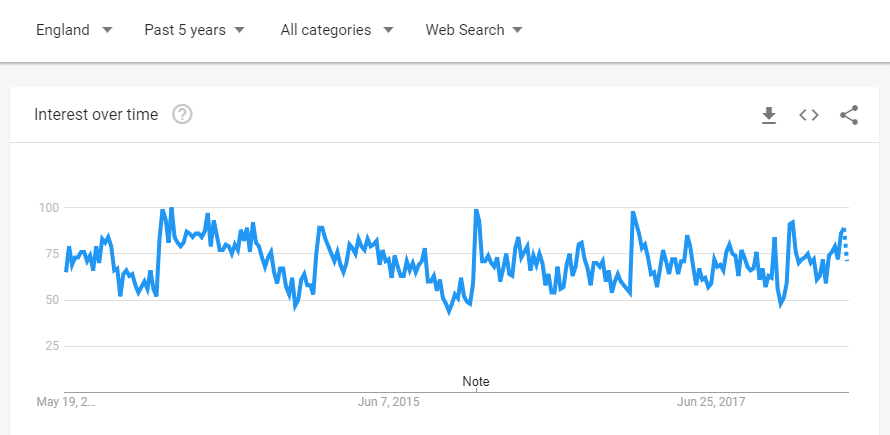
Keep in mind – we’re still looking at results for the same terms. In this scenario, Google Trends shows us that interest in running shoes spikes near the end of December and spills over into January. This is a bit odd, considering it’s the middle of winter in the UK, but hey, data doesn’t lie!
When you use Google Trends to research a keyword, you should narrow down which region you’re looking into. This way, you’ll be able to figure out if the content you want to write will do well in the country where your target readers are from.
If the keywords you’re looking into don’t do well in the country you want to target, then it’s time to look at other topic ideas, which is where the next section comes in.
3. Use Related Topics and Queries to Find New Blog Post Ideas
So far, we’ve only focused on the charts on Google Trends result pages. However, there’s more data that can help you. To give you an idea, let’s run another search for “WordPress” using worldwide results over the last five years:

We’ve already seen this chart, so let’s scroll down to the bottom of the page and look for the Related topics and Related queries sections. Here’s what the former looks like for the “WordPress” keyword:

The Related topics section tells you what else your search audience is looking for, besides WordPress-related content. Here, we can see that interest in site composers or builders has risen sharply over the last five years. Clicking through to the resulting chart verifies it:
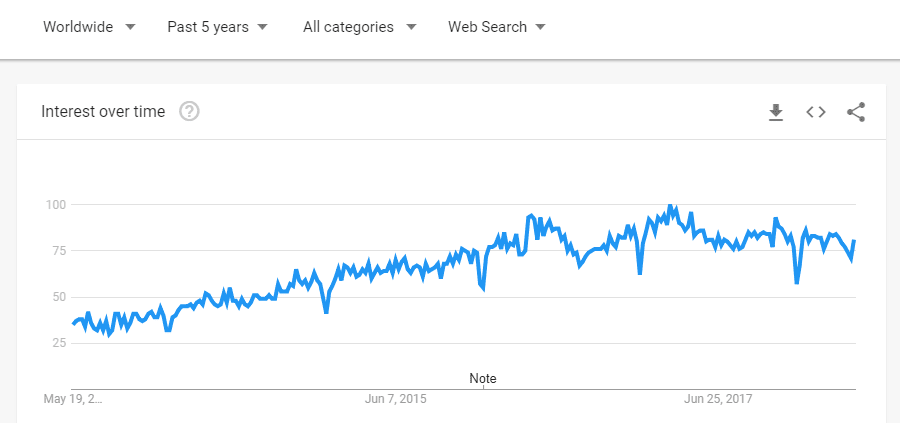
There are a lot of ups and down there, but overall, search volume has gone up. This tells us there are a lot of people interested in site builders overall. However, if you want to research specific keywords, you need to look at the Related queries section:

Those are the results when you look at WordPress-related queries over the past twelve months. Lately, Gutenberg has been the talk of the town, which is reflected in the results:
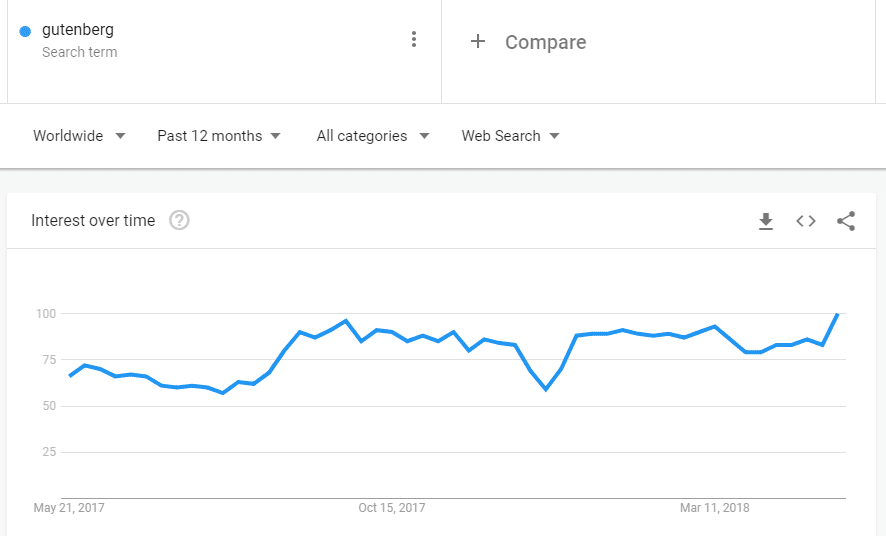
The main takeaway, in this case, is you can use Google Trends Related queries to help you identify related keywords people are looking for. From there, you can check out their individual trends and use the information to help you determine when to publish content about them.
Finally, if you want to play it safe, we recommend you doublecheck any potential keywords using both Google Trends and the Keyword Planner. With the latter, you’ll be able to verify if there’s enough search volume for any keywords you find using Google Trends, so your efforts don’t go to waste.
Conclusion
One of the best ways to figure out what people want to read about is to look at historic trends. Google Trends provides you with a simple way to check out how the public’s interest waxes and wanes for any keyword you want. With this data, you’ll be able to come up with better topic ideas and schedule them for times when you know your users will care the most about them.
Using Google Trends is simple, but figuring out how to make the most of the information it gives you can be complicated. Here are three ways you can use the data to help you create better topic ideas:
- Identify seasonal trends.
- Check out how keywords perform in specific regions.
- Use related topics and queries to find new blog post ideas.
Do you have any questions about how to use Google Trends to come up with new ideas for your blog? Let’s talk about them in the comments section below!
Article thumbnail image by wan wei / shutterstock.com.
The post How to Use Google Trends to Help You Come Up With New Blog Topic Ideas appeared first on Elegant Themes Blog.




